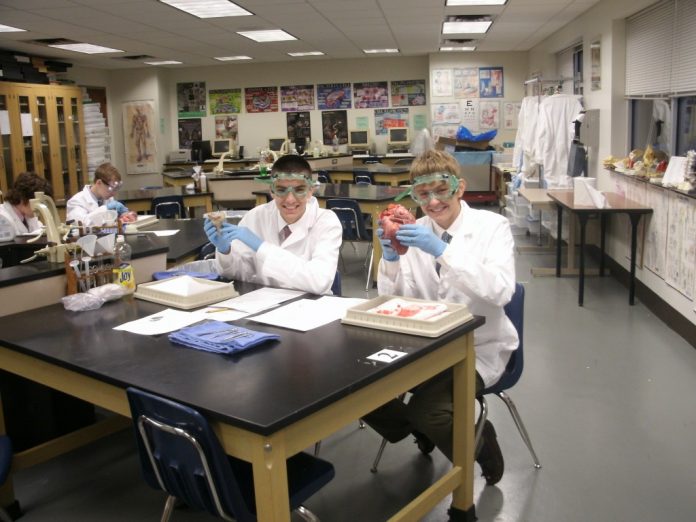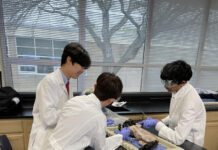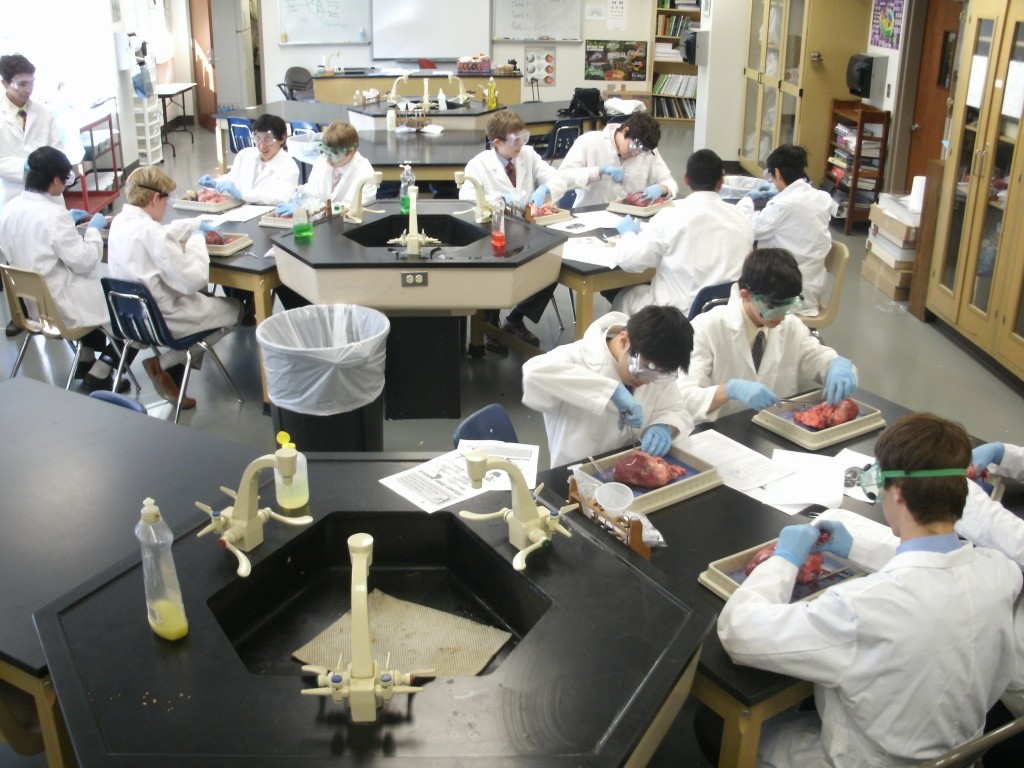 Instructed by biology teacher Mrs. Jan Jones, the Medical Society students quickly don both their safety coats and rubber gloves. Carefully choosing the right surgical tools for the procedure, they begin the meticulous task of dissecting the body of a cat. Precisely creating an incision down the center of the cat with a scalpel, the students identify the digestive system, heart, and other vital organs. A careful slice down the legs and shoulders, they recognize the gracilis muscle and the Biceps femoris muscle. With Mrs. Jones’s supervision, the dissectors properly dispose of the specimen and clean the tools. Stowing away the safety gear and tools, the accomplished students munch on a snack before they depart for their classes. This detailed procedure is only one of the many activities Mrs. Jan Jones, head of the Medical Society, offers her students throughout their four years in the Medical Society.
Instructed by biology teacher Mrs. Jan Jones, the Medical Society students quickly don both their safety coats and rubber gloves. Carefully choosing the right surgical tools for the procedure, they begin the meticulous task of dissecting the body of a cat. Precisely creating an incision down the center of the cat with a scalpel, the students identify the digestive system, heart, and other vital organs. A careful slice down the legs and shoulders, they recognize the gracilis muscle and the Biceps femoris muscle. With Mrs. Jones’s supervision, the dissectors properly dispose of the specimen and clean the tools. Stowing away the safety gear and tools, the accomplished students munch on a snack before they depart for their classes. This detailed procedure is only one of the many activities Mrs. Jan Jones, head of the Medical Society, offers her students throughout their four years in the Medical Society.
The Medical Society began fifteen years ago, and at that time there were only about six members. Today this club boasts 150 members, all participating in a myriad of activities to prepare them for the possibility of future medical careers. Mrs. Jones provides specialized procedures for all grade levels throughout the year in order to train students and guide them from simple dissections to  multifaceted clinical rotations. Freshmen participate in cat dissections, sophomores do structure function labs, juniors help out at nearby hospitals, and seniors help out at West Parker Clinic. All students are given the opportunity to travel to locations where they learn more about medical procedures. According to Mrs. Jones, “Each special activity like the cat dissection and structure function labs are 10 weeks, but for the juniors and seniors it’s ongoing. Seniors can shadow doctors and spend a few hours of the day with them during their practices.” Whether the students are taking a day trip to UT Southwestern or just doing a minor lab, Mrs. Jones enthusiastically guides them through many activities that a doctor would have to be familiar with.
multifaceted clinical rotations. Freshmen participate in cat dissections, sophomores do structure function labs, juniors help out at nearby hospitals, and seniors help out at West Parker Clinic. All students are given the opportunity to travel to locations where they learn more about medical procedures. According to Mrs. Jones, “Each special activity like the cat dissection and structure function labs are 10 weeks, but for the juniors and seniors it’s ongoing. Seniors can shadow doctors and spend a few hours of the day with them during their practices.” Whether the students are taking a day trip to UT Southwestern or just doing a minor lab, Mrs. Jones enthusiastically guides them through many activities that a doctor would have to be familiar with.
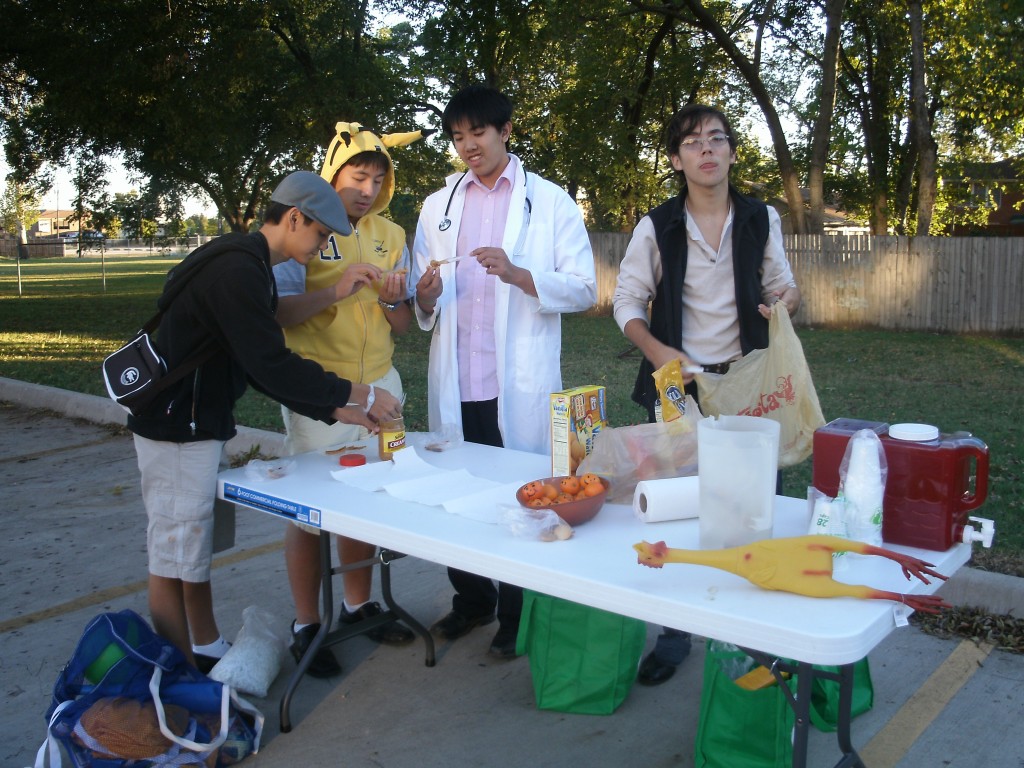 Boys have a natural calling to perform the gross process of dissecting animals. For freshmen, the Medical Society provides just this: an environment to explore and dissect the body of a cat. Ten weeks of dissecting cats gives a freshman the enthusiasm and excitement that stays with him past his senior year. Freshman In Han Hong remarks: “My favorite part about being in this club is that this club will be helpful when applying for college and it helps us experience a medical career.”
Boys have a natural calling to perform the gross process of dissecting animals. For freshmen, the Medical Society provides just this: an environment to explore and dissect the body of a cat. Ten weeks of dissecting cats gives a freshman the enthusiasm and excitement that stays with him past his senior year. Freshman In Han Hong remarks: “My favorite part about being in this club is that this club will be helpful when applying for college and it helps us experience a medical career.”
Taking the ideas and observations of dissections from freshman year, sophomores apply these skills to particular parts of the body. Called structure function labs, these activities help sophomores find the functions and characteristics of individual organs by running tests on them. Sophomore Todd Lim shares his experiences: “Structure function labs are fun and I learn a lot from them. My favorite part is the freedom to learn at your own pace and of your own choosing.” According to Mario Gamez, another sophomore: “The dissections are very informative and I enjoy learning something new concerning medicine in some form or manner.”
After having familiarized themselves with knowledge of dissections, juniors begin their work doing clinical rotations at West Parker Hospital and Walnut Hill Hospital.  Observing surgeries and various medical activities, they find out what really goes on in a hospital. Junior Patrick Bradshaw shares his thoughts about Walnut Hill Hospital: “At my clinical rotations at Walnut Hill Hospital, I’ve seen all kinds of injuries, treatments, hospital procedures, and people. Overall, I’ve had a lot of fun helping out the doctors and nurses there as they guide me through their processes of diagnosing and documenting, trying to teach me a little about working in a hospital. But the best part by far is seeing the smiles on the patients’ faces as they’re ready to be discharged and seeing them in such a happy mood, cracking jokes and generally enjoying the fact that they’re recovering and able to leave the hospital. I really enjoy getting the time to get a ‘behind the scenes’ look at what goes on in a hospital and what professions there are like. It’s fascinating to learn all about the different aspects that go into running and working at a hospital.”
Observing surgeries and various medical activities, they find out what really goes on in a hospital. Junior Patrick Bradshaw shares his thoughts about Walnut Hill Hospital: “At my clinical rotations at Walnut Hill Hospital, I’ve seen all kinds of injuries, treatments, hospital procedures, and people. Overall, I’ve had a lot of fun helping out the doctors and nurses there as they guide me through their processes of diagnosing and documenting, trying to teach me a little about working in a hospital. But the best part by far is seeing the smiles on the patients’ faces as they’re ready to be discharged and seeing them in such a happy mood, cracking jokes and generally enjoying the fact that they’re recovering and able to leave the hospital. I really enjoy getting the time to get a ‘behind the scenes’ look at what goes on in a hospital and what professions there are like. It’s fascinating to learn all about the different aspects that go into running and working at a hospital.”
Brian Buell, a junior, tells about an experience he had doing clinical rotations in West Parker’s Emergency Room: “I was able to get some hands-on experience, working with a patient who broke his arm. I assisted the doctor by holding the patient’s arm steady while he snapped the joint in the elbow of the broken arm back in place. In doing this, I really was able to see an example of the types of things that go on in the emergency room. So far in my clinical rotations, this has been the most memorable experience.”
Entering their final and most exciting year, seniors experience first-hand medical care at West Parker Clinic and UT Southwestern.  Right now, the seniors are involved in the West Parker Clinic in Plano. This clinic supports people who can’t afford medical care. Seniors can either attend on Wednesday or Saturday. This is also the first year seniors have done research at UT Southwestern during the summer. This past fall, the dean of UT Southwestern came to Jesuit to observe presentations on summer research. He explained to everyone that if they are 16 years of age or a high school junior, they can apply for a research position at UT Southwestern and receive payment for it during the summer.
Right now, the seniors are involved in the West Parker Clinic in Plano. This clinic supports people who can’t afford medical care. Seniors can either attend on Wednesday or Saturday. This is also the first year seniors have done research at UT Southwestern during the summer. This past fall, the dean of UT Southwestern came to Jesuit to observe presentations on summer research. He explained to everyone that if they are 16 years of age or a high school junior, they can apply for a research position at UT Southwestern and receive payment for it during the summer.
One of the most significant aspects of the Medical Society is their commitment to community service. According to Mrs. Jones, “We have a certain philosophy. Part of our club really gets involved in community service at Dallas Christian Ministries where we counsel families on diabetes prevention. Anyone can go on Thursday nights to work with people prone to this disease.” Another community service opportunity run by the Medical Society is the Medicine Drive, which is coming up very soon. Last year the Society took 450 pounds of medicine to Guatemala. These medical trips are the most important and anticipated service projects. The Society has travelled to El Salvador, Nicaragua, Honduras, and South Africa. The five days in either March or April, is not, as Mrs. Jones says, “to sightsee. We work 24/7 treating patients, distributing medicine, and taking care of people. It’s constant on-the-job work, but when we come back we understand how rewarding it is. We don’t go to change people’s lives; we can help only a bit.” Last year was the first year the Medical Society made really good contact with the Cuban doctors in Guatemala. Very impressed by the students’ work with the patients, the Cuban doctors want them to come back and work with them again. The Society will return, taking four doctors with them.
The Medical Society’s service and teaching is the culmination of the hard work of not only Mrs. Jones but also the determination of the students involved. Remarking on the enthusiasm of the students, Mrs. Jones notes: “I’ve actually had students who go into medical school because they’ve been in the Medical Society. Then I’ve had others in the Medical Society who decided it’s not for them, and that’s what it’s all about. The Medical Society is for everybody.”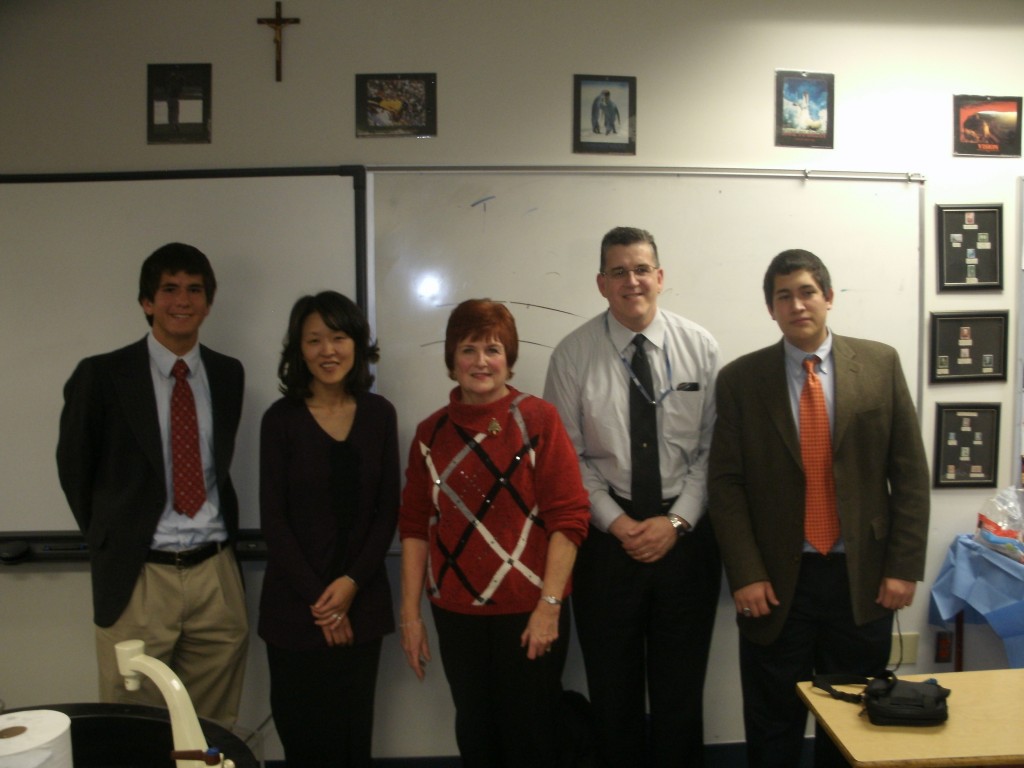
The students’ enthusiasm, as well as their commitment to service, can be summed up by the words of senior Jimmy Nawalaniec: “The Medical Society offers a wide range of medical related activities, from dissecting cats to travelling to South America, that help develop its members’ interests and skills in the natural sciences, especially ones geared toward the medical field.” Hopefully the Medical Society will continue their effective service and teaching, changing peoples’ lives, or at least trying to, for many years to come.


